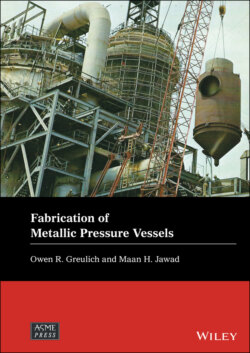Читать книгу Fabrication of Metallic Pressure Vessels - Maan H. Jawad - Страница 21
1.3.2.5 Component selection to eliminate operations
ОглавлениеDesign changes to eliminate whole operations are options to be considered. This category includes selection of vessel diameter to coincide with standard pipe sizes and the use of integrally reinforced designs. Figure 1.1 shows a detail of a hemispherical head where additional material on the outside is left in place to minimize machining cost.
If a shop rolled and welded vessel shell or nozzle can be replaced by a piece of off‐the‐shelf pipe, whether seamless or welded, then the costs for layout, crimp, and individually rolling that shell are all included in the pipe cost, which is typically produced in a dedicated facility that only produces pipe, but does it very efficiently. When this can be done, the material cost of the completed shell section is often little more than the material cost of the unrolled shell plate. A further benefit is that standard caps may then be available for use as vessel heads. These, too, being mass produced, will likely be significantly less expensive that custom‐formed heads.
When nozzles beyond a certain size penetrate a vessel wall, reinforcement is required to take the pressure loads that would otherwise have been transmitted through the material cut from the shell or head for placement of the nozzle. The ASME code puts limits on what material may be counted as contributing to this load carrying capability. Simple area replacement is typically used, provided that the reinforcing material is of strength equal to or greater than that of the material it is replacing. There are numerous ways of providing this material. Because the code allows essentially any material within a certain distance to be counted, any excess material in the shell itself, the nozzle wall, the weld, added reinforcing pads, or shell inserts, may be considered.
The best means of providing reinforcing beyond that inherent in the design is often fairly obvious, but in some cases a cost estimate for more than one approach may be needed to evaluate the trade‐off.
If a vessel has a limited number of penetrations requiring reinforcement, accepting the labor and material cost of providing reinforcement on a few nozzles may be inexpensive compared to providing a heavier shell that results in an integrally reinforced design. When a vessel has many nozzle penetrations requiring reinforcement, however, the labor associated with providing that reinforcement may far exceed the additional cost of a heavier shell wall and thicker shell and nozzle to shell welds. If most or all of the nozzles requiring reinforcement are located in the same area, it may make sense to make one shell course thicker than the others to provide integral reinforcement.
Figure 1.1 Outside machining of a hemispherical head
Another way of providing additional nozzle reinforcement when a flanged nozzle is required is the use of LWN flanges. If the nozzle protrusion is not excessive, then unless the cost of labor is extremely low or the cost of material extremely high (e.g., high nickel materials for their corrosion resistance or high temperature strength), it will almost always be more economical to use an LWN flange than to add a reinforcing pad. The neck of an LWN flange normally has an outside diameter equal to the hub diameter of a slip‐on flange, and it may be ordered in a variety of lengths. Thus, particularly if it is acceptable to allow the nozzle to protrude into the vessel, an LWN flange can almost always fulfill the need for additional reinforcement. While the cost of an LWN flange is significantly greater than that of either a slip‐on or a welding neck flange, it has the advantage of eliminating the following costs: flange to nozzle weld, reinforcing (or insert) plate, reinforcing or insert plate layout, forming of reinforcing plate, drilling and tapping of reinforcing plate vent hole, fit up of reinforcing plate, and welding of reinforcing plate both to the shell and to the nozzle.
